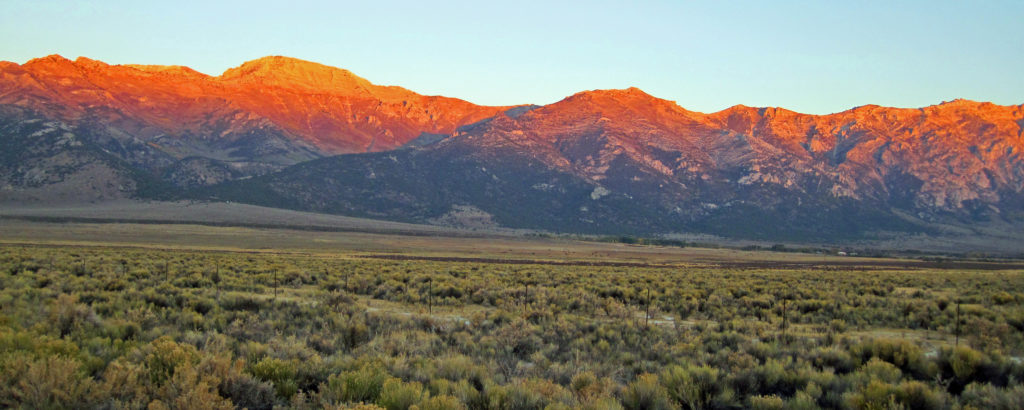
I may have seen more of the state of Nevada than most, but I certainly have not seen all of it. Nevada is such a vast state, over 110 thousand square miles ranking it the seventh largest state. Two New York states could fit into Nevada, or three Indiana states. One part of the state I have not visited is the lonesome northwest. I would love to see the Charles Sheldon Antelope Refuge or fish Knott Creek Reservoir, but they are 600 miles away… one way.
I have been as far north as Jarbidge, just south of the Idaho border. That was over forty years ago. Thirty-three years ago I passed through Elko to backpack the Ruby Mountains, and I fished the Ruby Marshes as recently as June 2000. I absolutely relished the rugged beauty of northeast Nevada, but there was something else attractive about it. Its vastness, combined with sparsely populated towns, gave it the feel of wilderness, a place of great possibilities awaiting exploration for those of strong bodies and spirits.
So, I hope you understand why when I needed to travel to Elko for the annual Nevada League of Cities (NLC) Conference I was compelled to carve out some time to explore and fish waters that captured my imagination so many years ago. My itinerary contemplated fishing Illipah Reservoir near Ely on Wednesday afternoon, and lodging in Ely that night. Thursday morning would find me on a White Pine County road through Long Valley on my way to the Ruby Marshes, perhaps crossing over Harrison Pass into Huntington Valley and then on up to Elko for the night. I was scheduled to participate in the NLC Conference on Friday, so I would be returning to Las Vegas on Saturday. The most direct round-trip was about 870 miles, and my side excursions added another 100 miles on top of that.
Illipah Reservoir
I arrived at Illipah about 11:00 AM after refueling in Ely. Although I took my time I was on the water by 11:30 AM after inflating the Outlaw Escape, assembling and setting up the equipment, and donning my waders and boots. I was surprised how many anglers were at the reservoir on a Wednesday afternoon in October. I suspected that there was news of good fishing and that these folks had no more will power to remain at work or in school than I would if informed of that reconnaissance.
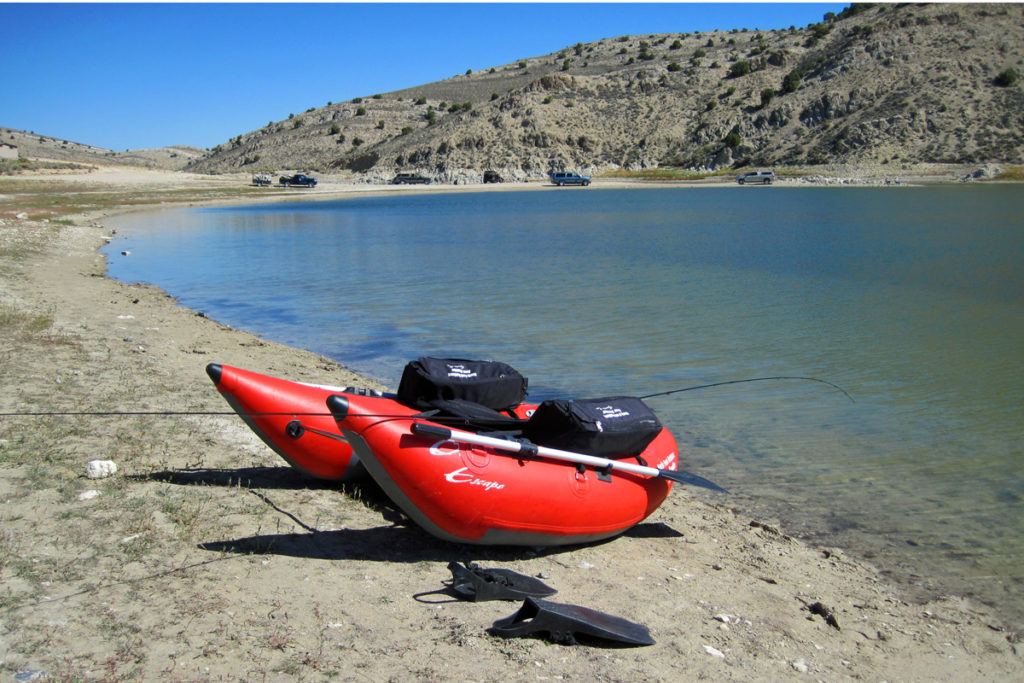
The latest into the year I had ever fished Illipah was mid-September when the weeds were still heavy and the weather warm. I was hoping this early October trip would find those conditions more fall-like, and that the Brown trout would be actively aggressive as they readied themselves for the fall spawn up Illipah creek. (A reminder that Rainbow and Cutthroat trout spawn during the spring, but Brown and Brook trout spawn in the fall, all requiring streams for successful breeding. One observed exception is Tasmanian rainbows that spawn in the fall due to their latitudinal confusion; see my Comins Reservoir blog for more on that oddity. The point about spawning is that the trout are always at their deepest, richest coloring when in spawn and often are the most aggressive towards lures.)
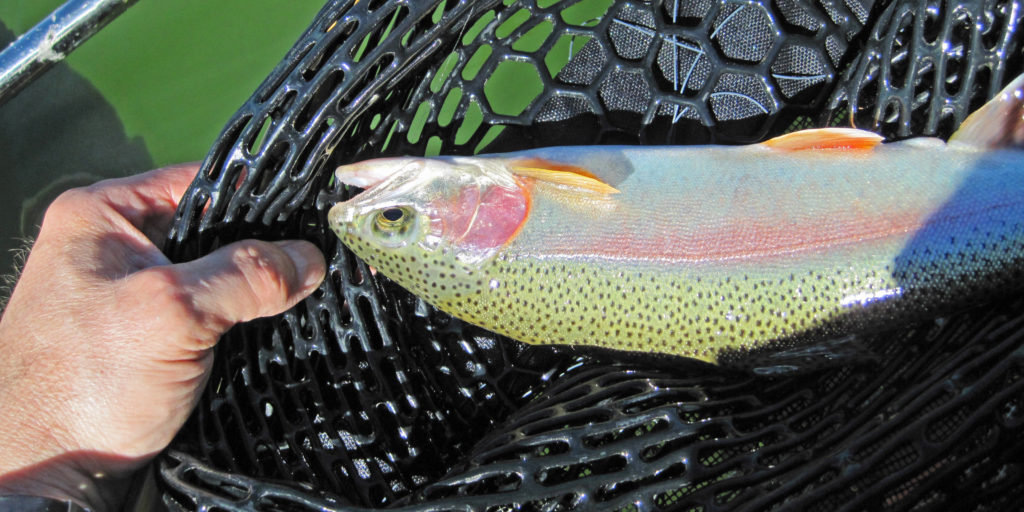
The fishing at Illipah was indeed excellent, averaging about five trout hooked per hour. More importantly to me they were mostly twelve to sixteen inches, with only three measuring closer to twelve. They fought very hard with the larger fish ripping line off my Galvin reel for short runs.
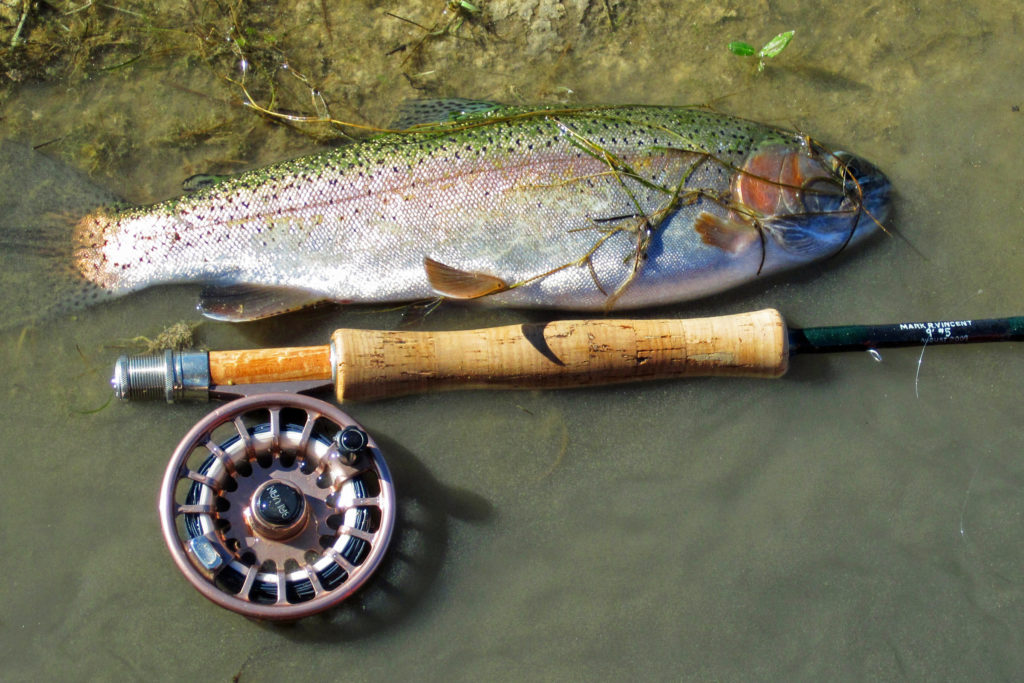
I started my fishing the middle of the large reservoir, mostly because that’s where I put in my Escape. The water was appropriately low for this time of year, but it was still a large body of water. After all, Illipah is a ranching reservoir that serves to water high-desert fields of alfalfa during the heat of the summer. Irrespective of where I started, my destination was the shallow water near the inlet; I was targeting the few, but wild Brown trout.
The action around the inlet was fantastic. After thirty-plus hook-ups over six hours my right forearm was tired. Through the warmth of the afternoon I was the only angler down there, but by about 4:00 PM another shore angler, a fly fisherman, joined me down there. Even from shore he experienced the same level of activity that I had from the float tube. Most of the bait anglers were assembled on the two dams fishing the deeper water. Although not always, bait anglers are usually found on or near the dams of reservoirs because the access is easier and the weed growth not so thick right up to the surface. I have always preferred the other end, near the inlet.
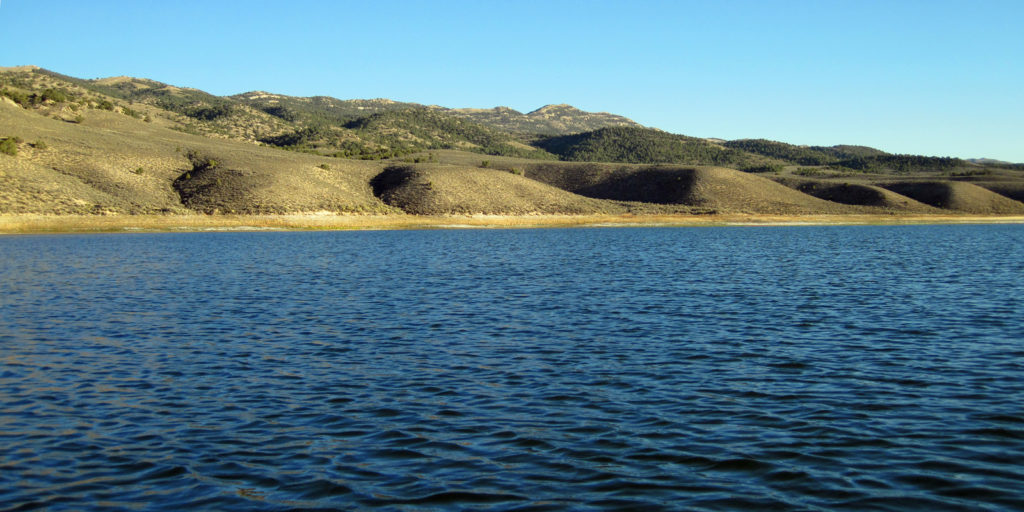
Despite targeting Brown trout, I did not land one. I did have one hooked for a while, and I did manage to get him to the surface whereupon his spawning dress of orange/brown was quite evident as it backdropped his large black spots haloed in white. I sized him to be at least as large as my largest rainbows of the day, but I admit I never did get him into the net for a more precise examination because he broke off the hook. Often times, it is the fish you lose, the one that you don’t land, that beckons you to return to their waters.
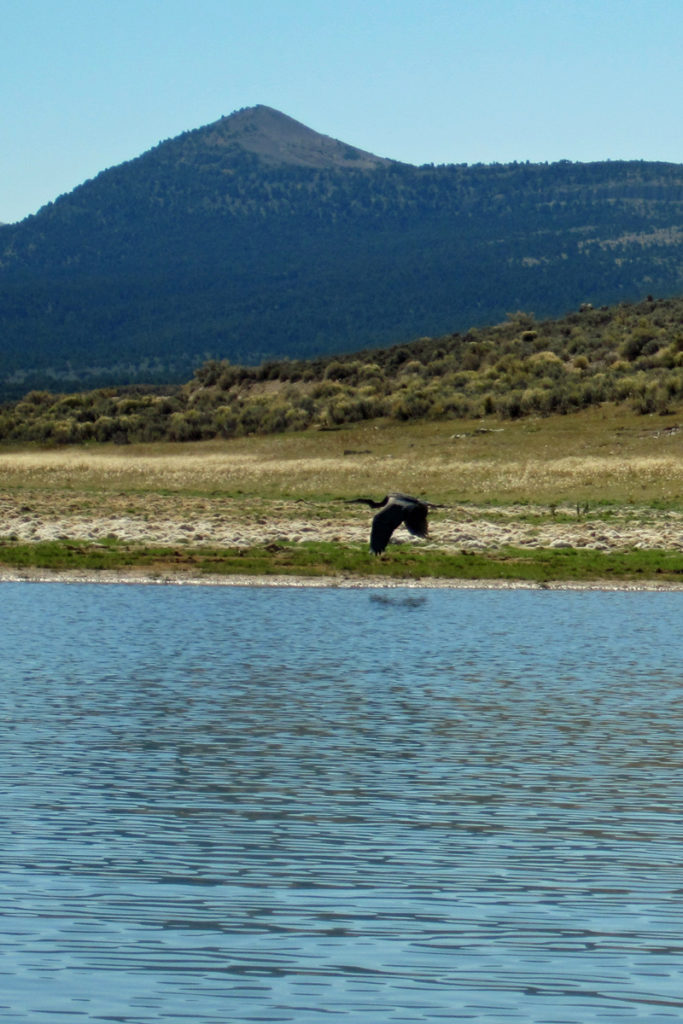
Illipah attracts a great variety of wildlife. This trip included herons, ospreys, coyotes, wild horses, and even a large crayfish that latched on to my small black nymph as it worked its way to the bottom of the inlet shallows. The osprey was working the reservoir throughout the afternoon. I witnessed him make four strikes into the water, two of which produced trout for him. The first trout was slightly too large for him, and he dropped the fish twice, losing it to reservoir depths the second time. I was more prepared for his second successful strike. Unlike bald eagles, ospreys hover fifty feet or more over fish they discover which telegraphs their intent before they dive bomb into the water. Then they sit in the water a few seconds before they take off from the water, hopefully with their catch in their talons. Knowing this allowed time to grab my camera and track the bird of prey as it was taking its supper to shore. What astonished me upon blowing up the picture (he was several hundred yards away and my camera only has a 3x optical telephoto lens) was that a coyote was in the background of the picture, no doubt scrounging for those plump crayfish.
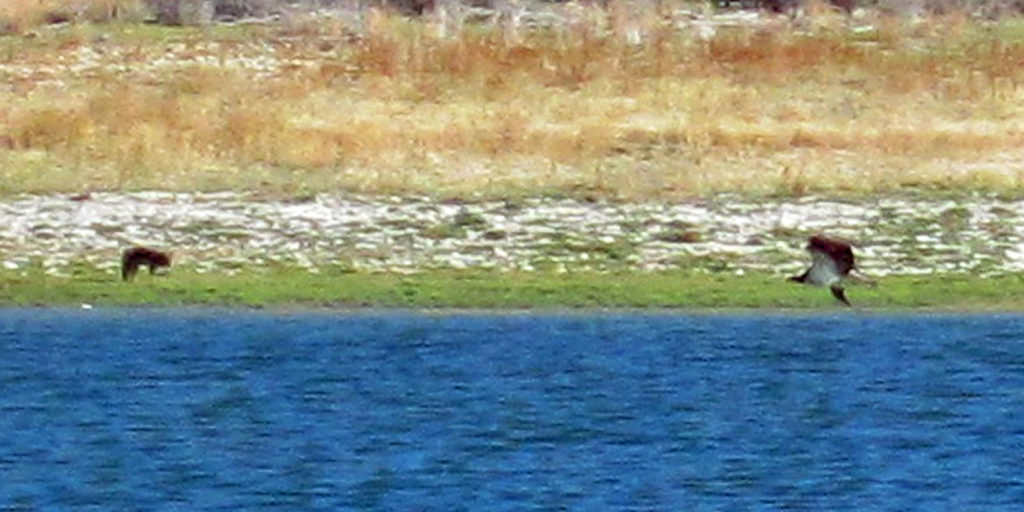
Ruby Marshes
It has been twelve years since I last fished the marshes on the east slope of the Ruby Mountains. The Ruby Mountain Range really is a magical place for outdoor and wildlife enthusiasts. My first awareness of the Rubies was from state fishing publications that described them as the Alps of Nevada. The range runs north-south for about seventy-five miles, spanning about fifteen miles at its widest point just south of Lamoille Canyon (I’m cheating somewhat here as I included the East Humboldt Range with the Rubies, which is about twenty miles long in its own right). In addition to its bounty of usual Nevada wildlife, it sports Rocky Mountain bighorn sheep and Mountain goat. The range is peppered with almost thirty alpine lakes in the nine to ten thousand foot elevation. The Ruby Crest Trail is thirty-eight miles long, which should attract the attention of some ultra-runners I know.
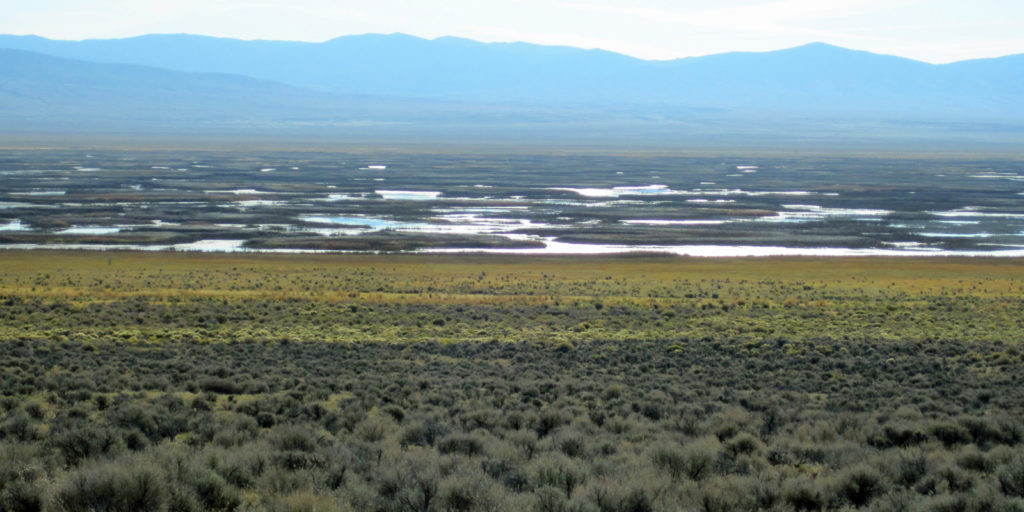
The Ruby Lake National Wildlife Refuge lies in the Ruby Valley east of the mountain range. I have always referred to these waters as the Ruby Marshes. Thursdsay I left Ely for the Ruby Marshes before sunrise and my truck thermometer registered twenty-eight degrees. It was a brisk fall morning. On the county road through Long Valley, a road I had all to myself in those early morning hours, I was taken aback by two wildlife encounters. The first was a herd of nine Pronghorn antelope grazing the foothills about thirty miles southeast of the Goicoechea Ranch. I had seen antelope on two other occasions, but in much smaller herds. The rising sun starkly contrasted their tawny hides against subdued greens of sage and juniper.
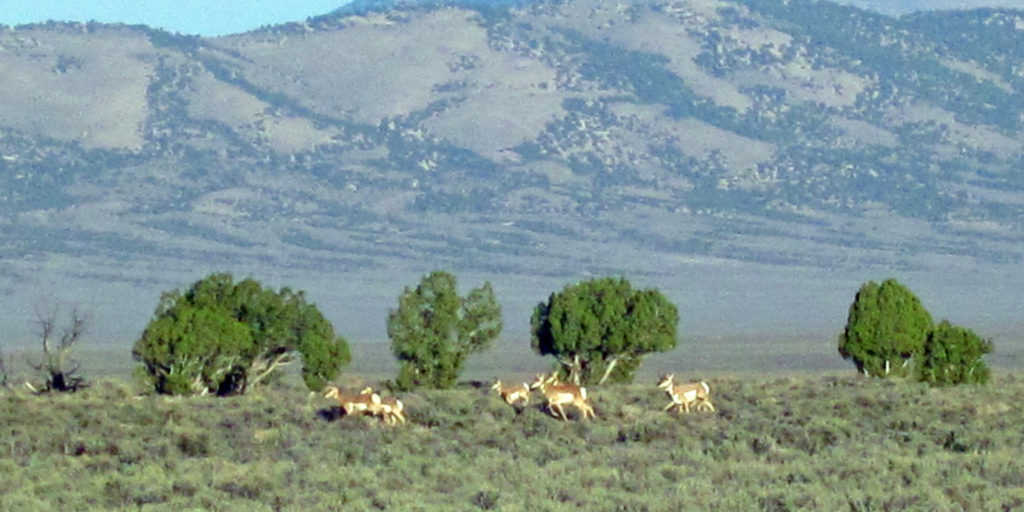
That was followed by a surprisingly close encounter with two mature Golden eagles. A bend in the road concealed them feeding on a rabbit carcass that was obviously recently run over. I slowed immediately and stopped to within forty feet or so. One immediately took off but the other stood there, rather defiantly. Having just set up the camera for the pronghorns I was able to snap a couple pictures through the dirty windshield.
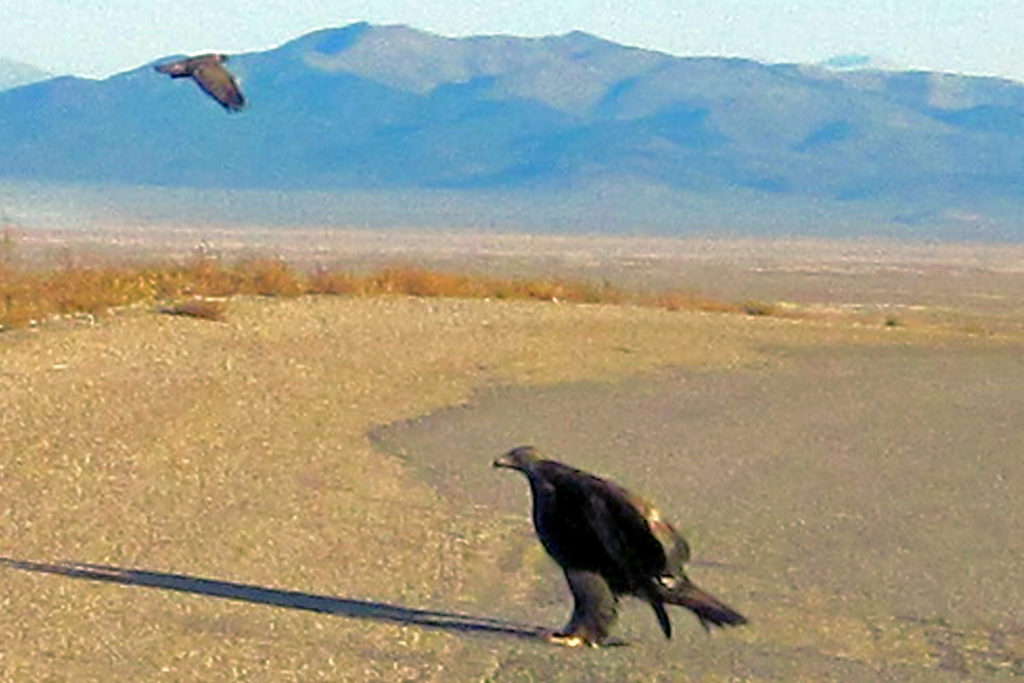
I have never fished the marshes directly, but had fished the Collection Ditch in 2000. The Collection Ditch seems to function as a manmade spring creek; it collects water from numerous springs on the east slope and delivers it into the marshes down by the Gallagher Fish Hatchery. The Ditch is very straight, but the spring water is very slow moving. I don’t know if there is any reproduction going on in there, but I doubt it. It does hold some very large trout, including the state record for a Rainbow trout.
I wanted this trip to focus on the marshes. I thought my NFO Outlaw Escape could scoot over the late season weeds to reach open water, but upon checking out the first three boat launch areas it looked impossible… well, ok, it just looked like too much work. On top of the thick weeds a cold front was blowing into the valley causing some strong gusts and I did not want to fight all that in a float tube, even if it was the best tube on the market. Consequently, I found the lower reach of the Collection Ditch, just south of the Gallagher Hatchery. The weed growth in the Ditch was also thick, but I managed to find a pool on the downstream side of a bridge culvert. I was relieved to see open water about fifty feet by thirty feet, but it was the dark shadows looming in the pool that really caught my attention.
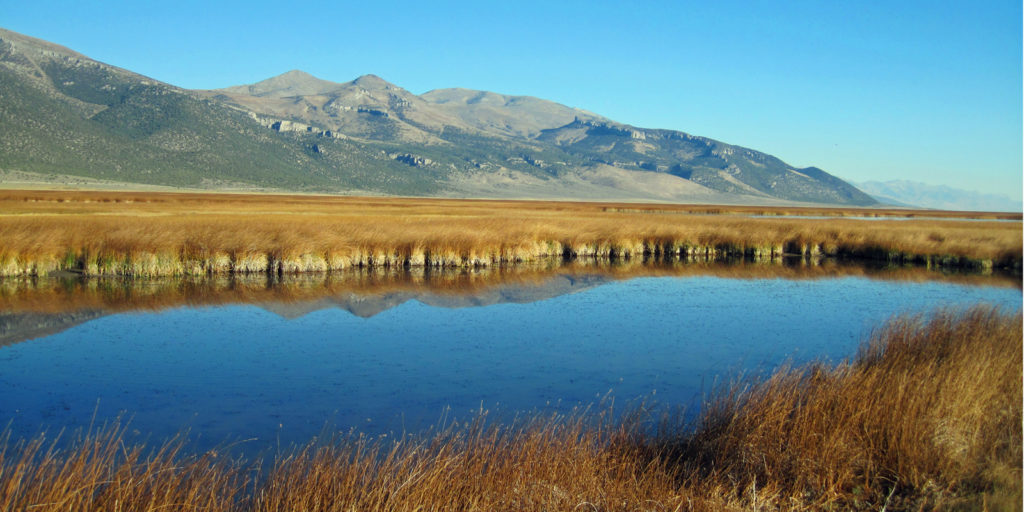
There were at least eight trout I could identify, and they were large. Since this was going to be more intimate, close quarters fishing I strung up my seven-and-one-half-foot rod for a four-weight line. I would not need my waders. No one was around for miles, and I took my time setting up while I watched the activity in the pool. I decided to try a nymph on an indicator, but quickly abandoned that. It just felt too elaborate for what was a straightforward situation. For the first thirty to forty-five minutes I tried several nymph patterns and one black gnat dry fly. I may have got a look or two, but nothing detectable. The water moves slowly and there are all sorts of odd currents as water spins out the sides of the culvert. A drag-free drift was difficult. I then switched to a size sixteen black nymph. I was casting upstream of the various targets and concentrating on the thick butt section of my leader beyond my floating line. Although I had to strip line in to keep pace with the current, I was watching for any telltale interruptions of that butt section. The clarity of the water and the angle of the sun glare also afforded me the opportunity to see the trout actions relative to where the fly was supposed to be, in some cases. I was about five to ten casts into the black nymph when I sensed it. I struck the fish and the calmness of the pool dissolved instantly into cartwheels and tail walks. I had the forethought to bring my eighteen-inch float tube net with me, which I needed to get the sixteen-inch Rainbow out of the water while stretching my 6x tippet.
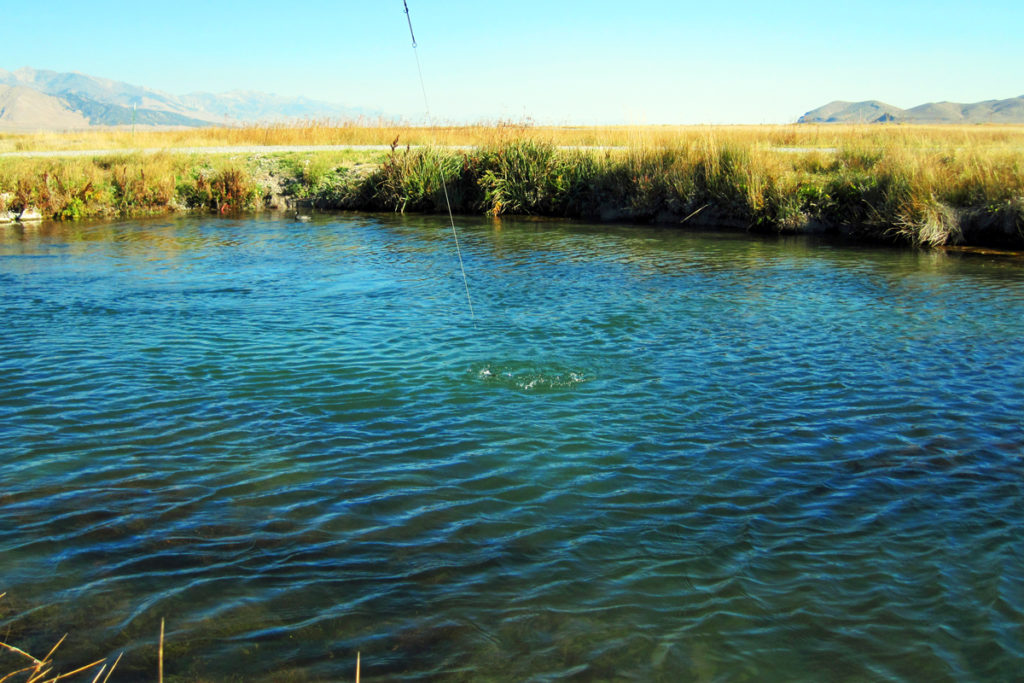
After taking my pictures, returning the trout in the tail of the pool, and calming down a little I inspected my fly and leader. Everything seemed ok except for the wind knot (i.e., overhand knot) that appeared about eight inches up from the fly. Sloppy casting, especially in windy conditions, can cause tailing loops that catch the fly and tie the leader into a knot. Wind knots then become the weakest point of connection, maybe cutting leader strength in half (i.e., three pound breaking strength reduced to one-and-one-half). I thought about clipping it out and re-tying the black nymph, but I was lazy or more likely impatient. Then I rationalized that all the commotion must have put all the fish down, or at the very least all the larger fish. I began doubting that I would get any more action. I was wrong. I cast the wind-knotted leader into the same current a few more times. On the third cast I had another one on the line. This one was decidedly larger or at least stronger. Just as I was getting all proud of myself the trout ran to the head of the pool and leaped. I saw his full body about thirty feet upstream; he was easily twenty inches, likely more. His re-entry into the water slammed the leader and broke it off right at the wind knot… the trout and fly were gone.
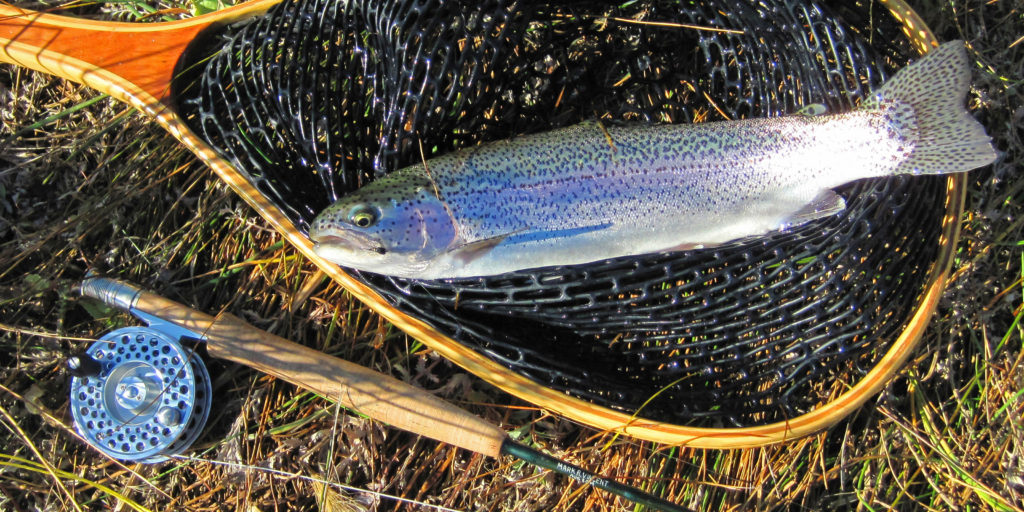
I tied on another black nymph and continued working the pool, but my heart wasn’t in it. I thought about taking a thirty minute break to let the fish settle down, but my mind wandered over to the west slope and the South Fork Reservoir (named for the South Fork of the Humboldt River). I also considered staying at this Ditch pool most of the day; it was likely to produce more good trout if I could be patient. Sight fishing is exciting, even if slow. Ultimately, exploration of the South Fork won over, but once I arrived I was disappointed. The community of Twin Bridges surrounded the reservoir giving it more of a commercial atmosphere. The water was low, and the Humboldt was practically dry from last year’s too mild winter. All that plus the blustering gusts pushing everything into the southeast shoreline caused me to take a rain check. I then momentarily regretted leaving the Collection Ditch pool.
Lamoille Canyon
My spirits quickly rose as I began to ponder Lamoille Canyon. I had not planned to visit it, but it began to pull me toward it. Next to Tahoe and the Truckee, Lamoille is likely the next most photographed natural wonder in northern Nevada, and I wanted to see it again after thirty-three years. I adjusted my itinerary and headed to Lamoille around 1:00 PM on Thursday.
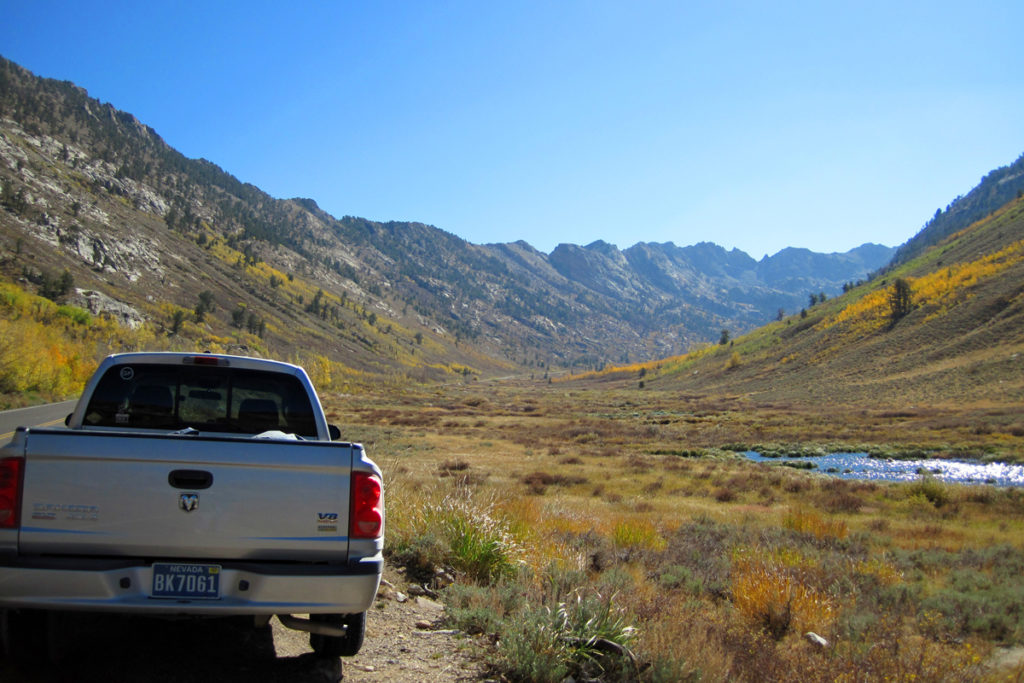
I recalled the marvelous U-shaped canyon being deceivingly long, probably because it makes that long, dogleg turn to the south. Still, driving it again seemed even longer than I remembered. Have you ever noticed that massive natural wonders grow smaller in your memory, and when you revisit them their new-again awe can humble your soul? As I said, I was not really considering fishing Lamoille, I was simply sightseeing. But then I saw it, the beaver pond. I knew instantly what I was going to do.
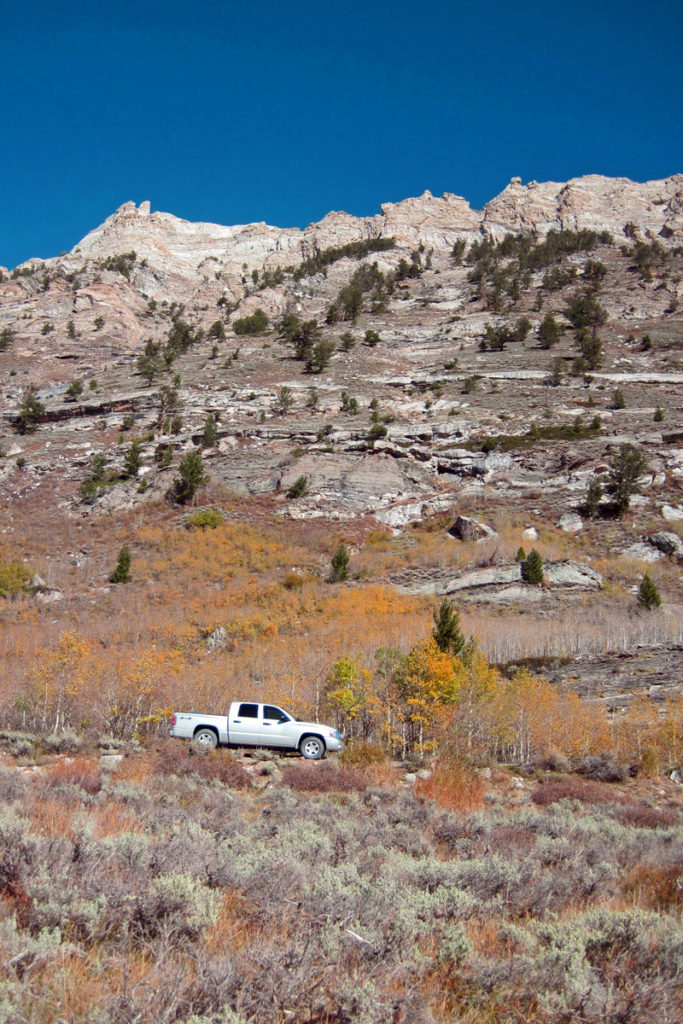
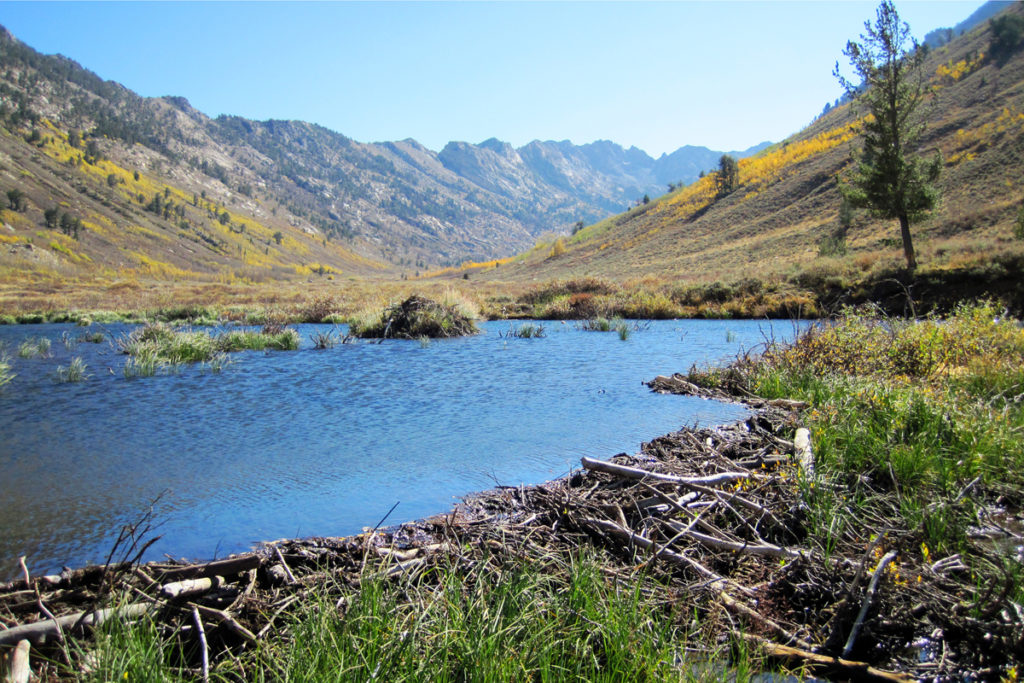

As I reassembled the light rod with a floating line, I would sneak peeks at the trout rise forms below the beaver dam (rise forms are the rings that occur when a trout is eating bugs on or near the surface of the water). After covering the short trail quickly I stopped to assess the situation again: no rise forms in the pond above the dam, numerous rise forms in the Lamoille Creek below the dam. That was simple. The creek is relatively shallow, so despite the rise forms I decided nymphs were the fly of choice. I was exclusively fishing callibaetis nymphs, and in thirty minutes I caught five trout: four Brook trout and one Tiger trout (Tigers are sterile hybrids of Brook trout crossed with Brown trout). Only one Brook trout came from the beaver pond. The Tiger was a surprising ten inches (likely recently stocked), and the wild Brookies were all six or seven inches. But it was the seven inch male Brookie, in full spawning regalia, that made the trip worthwhile. I soaked in his vibrant coloring: the sage-green vermiculated marks on his back, the green bleeding into his yellow belly, the bright orange fins with black, then white slashes along their edges, and the red spots with pale blue halos. It may have been one of the smallest fish of the trip, but it was the jewel of the trip.
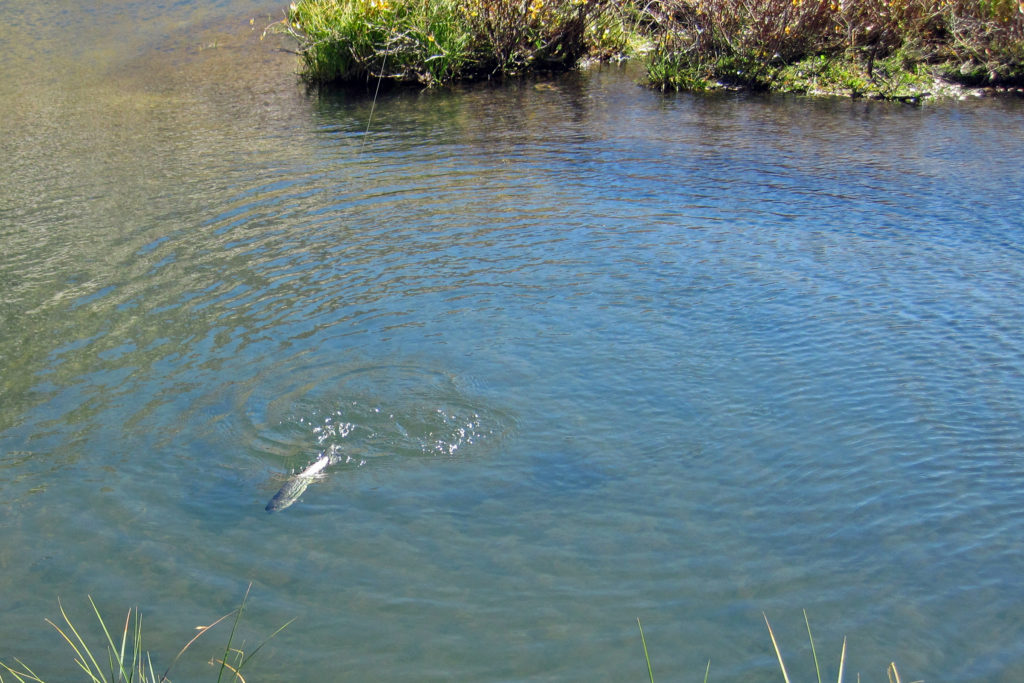
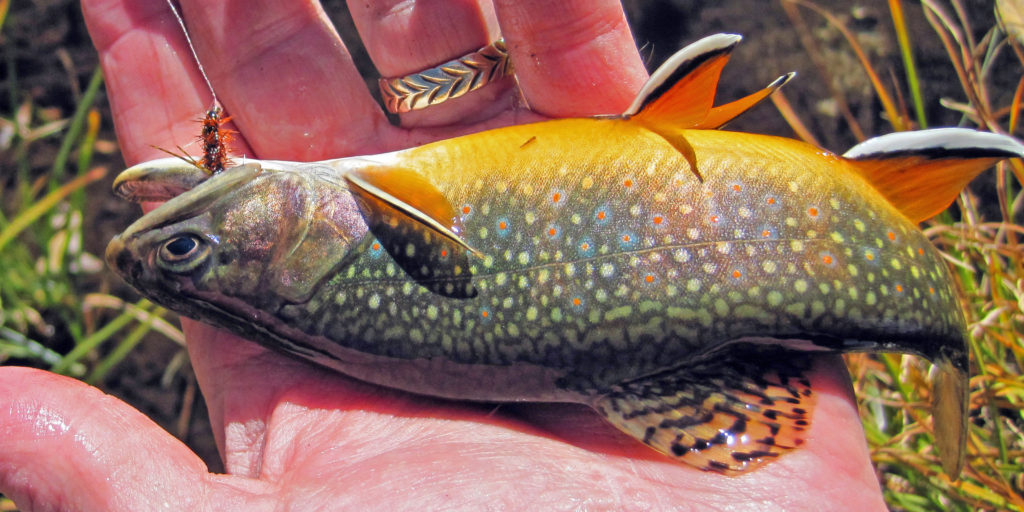
Friday was business, and on Saturday I arose at 5:30 AM and hit the road at 6:00 AM. It was dark, but the oncoming sunrise was lightening the southeast horizon a little. I headed east on I-80, finding Route 229 that split the gap between the Ruby Mountain and the East Humboldt ranges. After descending into North Ruby Valley the sun finally lit aflame the Ruby peaks. There must be lots of red flecks in the granite crags of the Rubies, enough so that when the beams of sunset or sunrise hit the mountaintops they radiate reddish-pink. As I continued east on State Route 229 towards U.S. 93, I became a little melancholy. But as the Ruby Mountains diminished behind me I realized how much I missed Denise, Brian, Evan, and Emily. I know that as much as I enjoy these outdoor adventures, I am nothing without the love of my family and friends. During the last meal, Jesus impressed upon his disciples the importance of love, of loving the Father though Him, and loving and serving each other as He did for us. John 13:35 quotes Jesus: “By this all men will know that you are my disciples, if you love one another.” Nature’s beauty can never take the place of love. I am ever thankful that my wife and family love me enough to support my occasional excursions, but these trips can never take the place of my love for them.
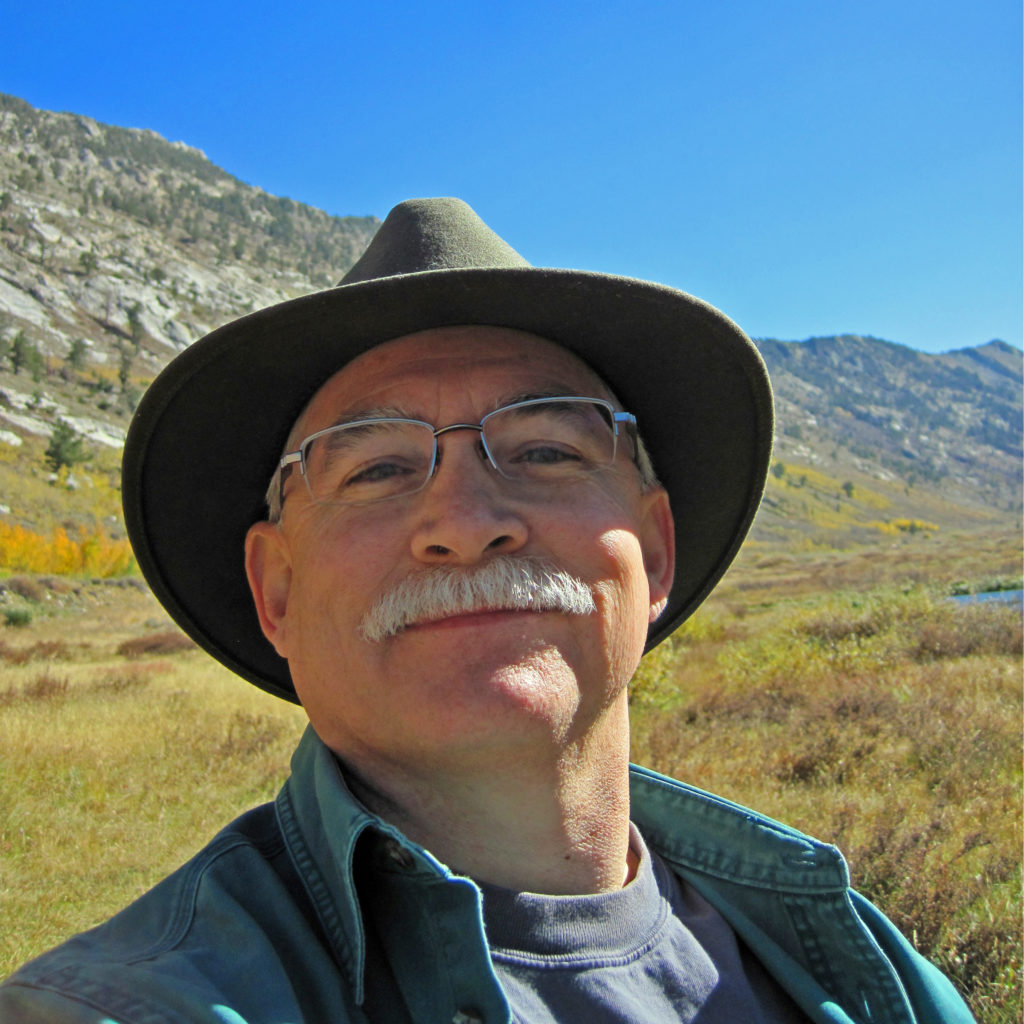
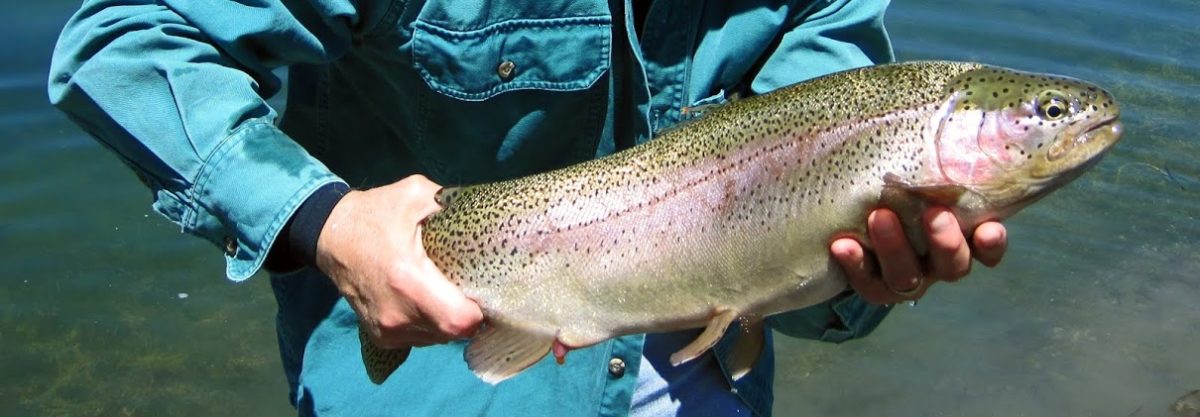
Nice trip…
What a great trip Mark, next run up North I am going with you!!Steve Ross
Great post! Maybe I'll check out that 38 miles sometime 🙂